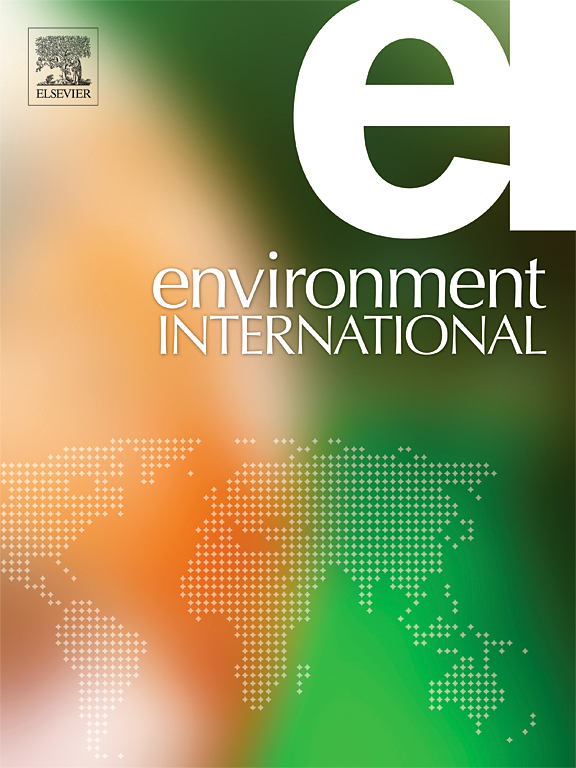揭示页岩气返排水对小球藻(Chlorella pyrenoidosa)生长的主要毒害因子及作用机制
IF 10.3
1区 环境科学与生态学
Q1 ENVIRONMENTAL SCIENCES
引用次数: 0
摘要
返排水已被证实对某些水生生物具有毒性,但由于其成分复杂多变,不同返排期的毒性作用及其潜在机制尚不清楚。在本研究中,分别在三个不同的反排阶段测试了废渣、去除大部分有机化合物的活性炭处理废渣(AC-FBW)和对核核小球藻的等效盐控制(SC)的毒性。它们的毒性随着返排时间的延长而增加,这是由于其组成的变化。通过生长抑制试验、细胞膜试验和氧化应激试验,与上述三组相比,AC-FBW的毒性最强,其次是SC和原FBW,说明FBW中的无机物对藻类生长起主要的毒性作用,模拟FBW毒性试验进一步验证了这一点。蛋白质组学分析表明,FBW通过抑制电子传递抑制藻类光合作用。抑制电子传递也导致超氧自由基增加,从而诱发氧化应激。此外,糖酵解和三羧酸(TCA)循环在FBW胁迫下上调。AC-FBW通过更大的改变电子传递和反应中心激活,从而引起更大的氧化应激和膜损伤,从而对藻类生长产生更强的抑制作用。AC-FBW中糖酵解和TCA循环的上调幅度也较大。本研究阐明了不同返排期的毒性效应,确定了FBW的主要毒性因素,为进一步优化废水处理工艺提供参考。本文章由计算机程序翻译,如有差异,请以英文原文为准。


Revealing the main toxic factor and mechanisms of shale gas flowback water on the growth of algae Chlorella pyrenoidosa
Flowback Water (FBW) have been proved to show toxicity towards some aquatic organisms, but the toxic effect across different flowback periods and underlying mechanism remained unclear due to their complex and changeable constitutes. In this study, the toxicity of FBW, the respective activated carbon treated FBW (AC-FBW) with most organic compounds removed, and equivalent salt control (SC) towards Chlorella pyrenoidosa were tested in three different flowback periods. Their toxicity increased with the duration of flowback time due to the change of composition. In comparison of above three groups, the AC-FBW showed the strongest toxicity through growth inhibition, cell membrane, and oxidative stress tests, followed by SC and original FBW, indicating that the inorganics in the FBW played primary toxicity factors on algae growth, which was further verified by the toxicity test of simulated FBW. Proteomic analysis demonstrated that FBW inhibited algal photosynthesis via inhibiting electron transport. The suppression of electron transport also led to the increase of superoxide radicals thereby inducing oxidative stress. Furthermore, glycolysis and Tricarboxylic Acid (TCA) cycle were up-regulated in response to FBW stress. AC-FBW caused stronger inhibition of algal growth through greater altering electron transport and reaction center activation, and then inducing more substantial oxidative stress and membrane damage. The up-regulation of glycolysis and TCA cycle was also greater in AC-FBW. This study elucidated the toxic effect in different flowback periods and identified the primary toxic factors of FBW, providing a reference for the further optimization of wastewater treatment technologies.
求助全文
通过发布文献求助,成功后即可免费获取论文全文。
去求助
来源期刊

Environment International
环境科学-环境科学
CiteScore
21.90
自引率
3.40%
发文量
734
审稿时长
2.8 months
期刊介绍:
Environmental Health publishes manuscripts focusing on critical aspects of environmental and occupational medicine, including studies in toxicology and epidemiology, to illuminate the human health implications of exposure to environmental hazards. The journal adopts an open-access model and practices open peer review.
It caters to scientists and practitioners across all environmental science domains, directly or indirectly impacting human health and well-being. With a commitment to enhancing the prevention of environmentally-related health risks, Environmental Health serves as a public health journal for the community and scientists engaged in matters of public health significance concerning the environment.
 求助内容:
求助内容: 应助结果提醒方式:
应助结果提醒方式:


